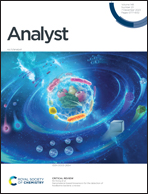Multiplexing potential of NIR resonant and non-resonant Raman reporters for bio-imaging applications†
Abstract
Multiplexed imaging, which allows for the interrogation of multiple molecular features simultaneously, is vital for addressing numerous challenges across biomedicine. Optically unique surface-enhanced Raman scattering (SERS) nanoparticles (NPs) have the potential to serve as a vehicle to achieve highly multiplexed imaging in a single acquisition, which is non-destructive, quantitative, and simple to execute. When using laser excitation at 785 nm, which allows for a lower background from biological tissues, near infrared (NIR) dyes can be used as Raman reporters to provide high Raman signal intensity due to the resonance effect. This class of imaging agents are known as surface-enhanced resonance Raman scattering (SERRS) NPs. Investigators have predominantly utilized two classes of Raman reporters in their nanoparticle constructs for use in biomedical applications: NIR-resonant and non-resonant Raman reporters. Herein, we investigate the multiplexing potential of five non-resonant SERS: BPE, 44DP, PTT, PODT, and BMMBP, and five NIR resonant SERRS NP flavors with heptamethine cyanine dyes: DTTC, IR-770, IR-780, IR-792, and IR-797, which have been extensively used for biomedical imaging applications. Although SERRS NPs display high Raman intensities, due to their resonance properties, we observed that non-resonant SERS NP concentrations can be quantitated by the intensity of their unique emissions with higher accuracy. Spectral unmixing of five-plex mixtures revealed that the studied non-resonant SERS NPs maintain their detection limits more robustly as compared to the NIR resonant SERRS NP flavors when introducing more components into a mixture.



 Please wait while we load your content...
Please wait while we load your content...